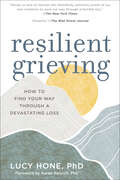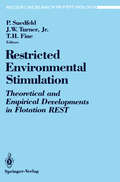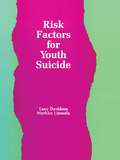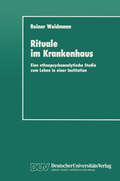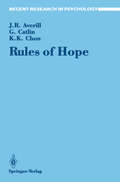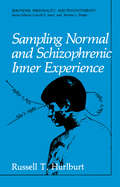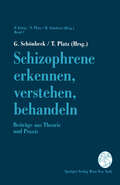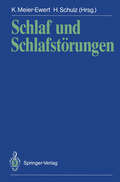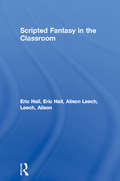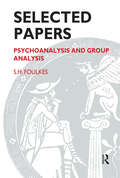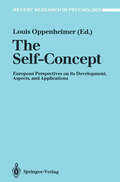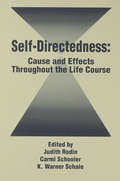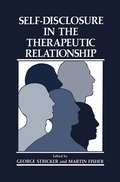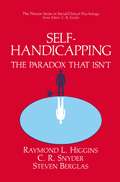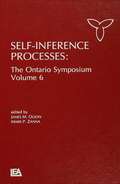- Table View
- List View
Resilient Grieving: How to Find Your Way Through a Devastating Loss
by Lucy Hone PhDResilient Grieving offers an empowering alternative to the five stages of grief—and makes clear our capacity for growth following the trauma of a loss that changes everything The death of someone we hold dear may be inevitable; being paralyzed by our grief is not. Recent research has revealed our capacity for resilient grieving, our innate ability to respond to traumatic loss by finding ways to grow—by becoming more engaged with our lives, and discovering new, profound meaning. Author and resilience/well-being expert Lucy Hone, a pioneer in positive psychology and bereavement research, was faced with her own inescapable sorrow when, in 2014, her 12-year-old daughter was killed in a car accident. By following the strategies of resilient grieving, she found a proactive way to move through her grief, and, over time, embrace life again. &“This book aims to help you relearn your world . . . to help you navigate the grieving process as best you can—without hiding from your feelings or denying the reality, or significance, of your loss.&”—from Resilient Grieving
Restricted Environmental Stimulation: Theoretical and Empirical Developments in Flotation REST (Recent Research in Psychology)
by Thomas H. Fine John W. Turner PeterSuedfeldPreviously reported results of sensory-deprivation experiences, of which flotation REST is an instance, were dramatic, generally negative and ultimately unreliable. This book offers controlled systematic research on the effects of flotation REST. The papers in this collection were chosen from those presented at the first three international conferences on REST and fall into several categories. The major category concerns theoretical formulations for REST effects; other categories in the collection deal with experimental findings and clinical research in relation with flotation REST.
Risk Factors for Youth Suicide (Death Education, Aging and Health Care)
by Lucy Davidson Markku LinnoilaFirst published in 1990. Routledge is an imprint of Taylor & Francis, an informa company.
Risk Factors for Youth Suicide (Death Education, Aging and Health Care)
by Lucy Davidson Markku LinnoilaFirst published in 1990. Routledge is an imprint of Taylor & Francis, an informa company.
Rituale im Krankenhaus: Eine ethnopsychoanalytische Studie zum Leben in einer Institution
by Reiner WeidmannRules of Hope (Recent Research in Psychology)
by James R. Averill George Catlin Kyum K. ChonHope has been called the "life blood of the soul", an indispensable condition for human existence. Yet evidence in this book suggests that hope is neither a necessary nor a universal part of life. Rather, hope is constituted in accordance with cultural norms, and hence it may vary fundamentally from one society to another. In the first of four studies, Averill, Catlin, and Chon delineate four classes of rules that help constitute hope in Western societies. A second study examines the similarities and differences between hope and other, more prototypic emotions, such as anger and love. The third study uses content analyses of maxims and metaphors to clarify further the Western model of hope. In the fourth study, hope is compared with himang, its closest counterpart in Korea. The results of these studies provide the basis for an analysis of the functions of hope, on both the individual and social levels. But this book is not simply about hope. It is also about emotions in general. Current psychological theories focus on emotions that have distinct physiological components (e.g., fear and anger) and that can be investigated using animal models. As a consequence, our theories have a strong biological orientation. How would our theories change if they were to encompass more cognitively oriented emotions, such as hope? Rules of Hope provides some answers to this question.
Sampling Normal and Schizophrenic Inner Experience (Emotions, Personality, and Psychotherapy)
by Russell T. HurlburtWhat are the basic data of psychology? In the early years of experimental psychology, they were reports of ''brighter'' or "heavier" or other esti mates of the magnitude of differences between the sensory stimuli pre sented in psychophysical experiments. Introspective accounts of the ex perience of seeing colored lights or shapes were important sources of psychological data in the laboratories of Cornell, Harvard, Leipzig, or Wiirzburg around the tum of the century. In 1910, John B. Watson called for the objectification of psychological research, even parodying the typical subjective introspective reports that emerged from Edward Bradford Titchener's laboratory. For almost fifty years psychologists largely eschewed subjective information and turned their attention to observable behavior. Rats running mazes or pigeons pecking away on varied schedules of reinforcement became the scientific prototypes for those psychologists who viewed themselves as "doing science. " Psychoanalysts and clinical psychologists sustained interest in the personal reports of patients or clients as valuable sources of data for research. For the psychologists, questionnaires and projective tests that allowed for quantitative analysis and psychometrics seemed to circum vent the problem of subjectivity. Sigmund Freud's introduction of on going free association became the basis for psychoanalysis as a therapy and as a means of learning about human psychology. Slips-of-the tongue, thought intrusions, fantasies, hesitations, and sudden emo tional expressions became the data employed by psychoanalysts in for mulating hypotheses about resistance, memory, transference, and a host of presumed human wishes and conflicts.
Schizophrene erkennen, verstehen, behandeln: Beiträge aus Theorie und Praxis (Aktuelle Probleme der Schizophrenie #1)
by G. Schönbeck T. PlatzSchizophrenia: Concepts, Vulnerability, and Intervention
by KurtHahlweg Eckart R. StraubeSchizophrenia remains the most complex, puzzling, and because of its tendency towards chronicity, the most severe of the mental disorders. It is a very heterogeneous disorder characterized by extreme disruptions of thought, per ception, behavior, and emotion. About I % of the population worldwide will experience at least one schizophrenic episode. Most of the patients will have a number of exacerbations leading in about 30% of cases to a chronic residual state, due either to the illness itself or to psychosocial environmental factors, or-most likely-to the interaction of both. Given the enormous personal hardship for patients and their relatives as well as the staggering costs of the illness for our societies, research in schizo phrenia has become the number one priority in many countries, especially in the United States. However, research on the etiology of schizophrenia has failed to establish a single causal factor, and it is nowadays accepted to be multifactorial. A combjnation of biological predisposition and enviromnental circumstances is assumed to be necessary for the manifestation of the illness. This shift in orientation away from an either/or (biological or environmental, e.g., family interaction) point of view, as evident in the work of the 1950s and 1960s, was certainly desirable to encourage research.
Schizophrenie und Alkohol: Zur Psychopathologie schizophrener Bewältigungsstile (Monographien aus dem Gesamtgebiete der Psychiatrie #61)
by Joachim ZeilerSchlafstörungen in der Praxis: Diagnostische und therapeutische Aspekte. Symposium zum 38. Deutschen Kongreß für Ärztliche Fortbildung Berlin 1989
by G.A.E. Rudolf A. EngferScripted Fantasy in the Classroom
by Eric Hall Alison LeechMany teachers have tried simple relaxation techniques in their classrooms and been surprised by their success. This step by step guide to the technique of scripted fantasy shows how the forces of the imagination can be harnessed to improve the social skills and classroom performance of students of all ages and all abilities. It provides sample scripts to get the teacher started, and gives advice on classroom management and on processing the fantasy experience without compromising students' privacy.
Scripted Fantasy in the Classroom
by Eric Hall Alison LeechMany teachers have tried simple relaxation techniques in their classrooms and been surprised by their success. This step by step guide to the technique of scripted fantasy shows how the forces of the imagination can be harnessed to improve the social skills and classroom performance of students of all ages and all abilities. It provides sample scripts to get the teacher started, and gives advice on classroom management and on processing the fantasy experience without compromising students' privacy.
Secrets About Men Every Woman Should Know
by Barbara De AngelisSome diagrams in this title are best viewed on a tablet device.
Selected Papers: Psychoanalysis and Group Analysis
by S.H. FoulkesThe collection of the author's papers, which includes some unpublished material and some published in English for the first time, comprises not only the later Group-Analytic writings but also those from the first part of his career as a psychoanalyst. Among the latter, the paper "On Introjections" is of particular interest and importance.
Selected Papers: Psychoanalysis and Group Analysis
by S.H. FoulkesThe collection of the author's papers, which includes some unpublished material and some published in English for the first time, comprises not only the later Group-Analytic writings but also those from the first part of his career as a psychoanalyst. Among the latter, the paper "On Introjections" is of particular interest and importance.
Selective Incapacitation and the Serious Offender: A Longitudinal Study of Criminal Career Patterns (Research in Criminology)
by Rudy HaapanenAnd if thy right hand offend thee, cut it off, and cast it from thee; for it is profitable for thee that one ofthy members should perish, and not that thy whole body should be cast into hell. Matthew 5. 30 The great War on Pover,ty of the 1960s focused on the root causes of crime, unemployment, lack of education, and discrimination. It was eventually agreed that the War on Poverty failed as a crime control program, and the focus of policy shifted toward more proximate causes of crime. Infact, it seems safe to say that since the 1960s, the United States has looked primarily to the criminal justice system to solve its crime problem. With the 1990s upon us, what can we say about the success of crime control policies that rely on the criminal justice system? The picture, taken one approach or program at a time, is not good. It is now generally agreed that the criminal justice system fails to rehabilitate offenders, to make them less likely to commit criminal acts as a result of treatment or training; that the system fails to deter potential offenders, to make them less likely to commit criminal acts out of fear of penal sanctions; and that such programs as increased police patrols, reinstatement of the death penalty, and modification of the exclusionary rule are unlikely to have much effect on crime, at least within the limits imposed on them by reasonable assessments of their costs.
The Self-Concept: European Perspectives on its Development, Aspects, and Applications (Recent Research in Psychology)
by Louis OppenheimerFrom the Preface: "The purpose of this book is to present the state-of-the-art of the study of the self-concept in Eastern and Western Europe. It offers an overview of the type of questions, points of emphasis, employed methodologies, and major findings in the various European countries... while some of the issues treated in this book relate to well researched areas in the study of the self-concept, others present new ideas, approaches, and methodologies."
Self Directedness: Cause and Effects Throughout the Life Course (Social Structure and Aging Series)
by Judith Rodin Carmi Schooler K. Warner SchaieThis book, the third in a series on the life course, has significance in today's world of research, professional practice, and public policy because it symbolizes the gradual reemergence of power in the social sciences. Focusing on "self-directedness and efficacy" over the life course, this text addresses the following issues:* the causes of change* how changes affect the individual, the family system, social groups, and society at large* how various disciplines--anthropology, sociology, psychology, epidemiology--approach this field of study, with consideration given to common themes and differencesFinally, an effort is made to develop a multidisciplinary perspective unique to the study of self-directedness and efficacy.
Self Directedness: Cause and Effects Throughout the Life Course (Social Structure and Aging Series)
by Judith Rodin Carmi Schooler K. Warner SchaieThis book, the third in a series on the life course, has significance in today's world of research, professional practice, and public policy because it symbolizes the gradual reemergence of power in the social sciences. Focusing on "self-directedness and efficacy" over the life course, this text addresses the following issues:* the causes of change* how changes affect the individual, the family system, social groups, and society at large* how various disciplines--anthropology, sociology, psychology, epidemiology--approach this field of study, with consideration given to common themes and differencesFinally, an effort is made to develop a multidisciplinary perspective unique to the study of self-directedness and efficacy.
Self-Disclosure in the Therapeutic Relationship
by George Stricker Martin FisherThe editors of the present volume were also privileged to collaborate on an earlier book, Intimacy, also published by Plenum Press. In our pref ace to that volume, we described the importance and essence of inti macy and its centrality in the domain of human relationships. After reading the contributions to that volume, a number of issues emerged and pressed for elaboration. These questions concerned the nature and parameters of intimacy. The natural extension of these con cerns can be found in the current work, Self-Disclosure in the Therapeutic Relationship. The editors, after careful consideration of the theoretical, philo sophical, and technical literature, are impressed by the relationship between intimacy and appropriate self-disclosure. Self-disclosure, in this context, refers to those behaviors that allow oneself to be suffi ciently revealing so as to become available for an intimate relationship. Levenson has referred to psychotherapy as the demystification of expe rience wherein intimacy emerges during the time that interpersonal vigilance diminishes through growing feelings of safety. Interpersonal experience can be demystified and detoxified by disclosure, openness, and authentic relatedness. This is not an easy process. Before one can be open, make contact, or reach out with authenticity, one must be available to oneself. This means making contact with-and accepting-the dark, fearful, and of ten untouched areas within the person that are often hidden even from oneself. The process of therapy enables those areas to gain conscious ness, be tolerated, and be shared with trusted others.
Self-Handicapping: The Paradox That Isn’t (The Springer Series in Social Clinical Psychology)
by Raymond L. Higgins C.R. Snyder Steven BerglasThe concept of self-handicapping can be legitimately anchored in a vari ety of intellectual contexts, some old and some newer. As this volume reminds us, Alfred Adler was perhaps the first to articulate the signifi cance of various self-defeating claims and gestures for protecting the self concept. Thus the apparent paradox of "defeat" in the interests of "pro tection. " More recently (but still more than 30 years ago), Heider's "naive psychology" added attributional rhetoric to the description of self-defeat ing strategies. While predominantly cognitive in its thrust, the attribu tional approach incorporated several motivational influences-especially those involving egocentric concerns. Heider hardly violated our common sense when he suggested that people are inclined to attribute their performances in a self-serving manner: the good things I caused; the bad things were forced upon me. The notion of self-handicapping strategies, proposed by Berglas and myself a little more than a decade ago, capitalized on these homely truths while adding a particular proactive twist. We not only make ex cuses for our blunders; we plan our engagements and our situational choices so that self-protective excuses are unnecessary. In doing so, we use our attributional understanding to arrange things so that flawed and failing performances will not be interpreted in ways that threaten our self-esteem.
Self-Inference Processes: The Ontario Symposium, Volume 6 (Ontario Symposia on Personality and Social Psychology Series)
by James M. Olson Mark P. ZannaAlthough self-inference processes -- the ways individuals make judgments about themselves -- have been studied in social psychology and sociology for many years, a distinct literature on this topic has not emerged due to the diversity of relevant issues. The editors of this current volume cull recent social psychological research and theory on self-inference processes and identify some of the common themes in this area of study. The specific topics covered in this volume include: ` how people infer their emotions, personality traits, and body images from relevant information * factors influencing the self-concept, identity, and self-standards * the impact of self-inferences on interpersonal relations * conditions motivating escape from the self The book is written for researchers and graduate level students in clinical, social, developmental, health, and personality psychology.
Self-Inference Processes: The Ontario Symposium, Volume 6 (Ontario Symposia on Personality and Social Psychology Series)
by James M. Olson Mark P. Zanna C. Peter HermanAlthough self-inference processes -- the ways individuals make judgments about themselves -- have been studied in social psychology and sociology for many years, a distinct literature on this topic has not emerged due to the diversity of relevant issues. The editors of this current volume cull recent social psychological research and theory on self-inference processes and identify some of the common themes in this area of study. The specific topics covered in this volume include: ` how people infer their emotions, personality traits, and body images from relevant information * factors influencing the self-concept, identity, and self-standards * the impact of self-inferences on interpersonal relations * conditions motivating escape from the self The book is written for researchers and graduate level students in clinical, social, developmental, health, and personality psychology.
